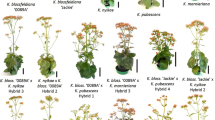Abstract
In this study, we studied the phenotypic and breeding efficiency of Phalaenopsis reciprocal hybrids and their parents. For reciprocal hybridization, Phalaenopsis ‘KS Little Gem’ and ‘1747’ from Taiwan were used as parents. After crossing ‘KS Little Gem’ × ‘1747’ in 2010, 34 individuals from ‘KS 1059’ hybrids were developed. The crossing between ‘1747’ × ‘KS Little Gem’ resulted in the development of 63 individuals from ‘KS 1076’ hybrids. Detailed morphological characteristics of newly developed hybrids; ‘KS 1059’, ‘KS 1076’ and their parents were collected according to guidelines determined by the Korea Seed and Variety Service (KSVS). The leaf characteristics were similar in reciprocal hybrids and their parents, except in number of leaves, which as were maximal in ‘KS 1059’. In terms of flower characteristics including number of flowers, inflorescence length, pedicel length and pedicel diameter, features of the parents were combined in the hybrids. By contrast in case of flower length, both hybrids showed similarity to ‘KS Little Gem’, and a similar pattern was observed in flower width. The petal length in hybrids and parents were similar, but the petal width of hybrids was more closer to that of ‘KS Little Gem’. The length of whiskers was long in both parents, but very short whiskers were recorded in hybrids. The length and width of the apical lobe were similar in parents and hybrids, but hybrids were closer to ‘1747’. In the case of duration of of flowering, the maximum value of 123 days was recorded in ‘KS Little Gem’ similar to ‘KS 1059’, whereas ‘1747’ and ‘KS 1076’ had almost identical values. It can be concluded that to generate Phalaenopsis with a longer shelf life, ‘KS Little Gem’ might be selected as the female parent during hybridization.
Similar content being viewed by others
References
Arditti, J. 1979. Aspects of the physiology of orchids. Adv. Bot. Res. 7:421–655.
Ashman, T.L. and D.J. Schoen. 1994. How long should flowers live? Nature 371:788–791.
Christenson, E.A. 2001. Phalaenopsis. Timber Press, Portland, Oregon, USA.
Chung, W.B., Y.S. Chung and P.S. Hwang. 2003. Genetic analyses on quantitative characters of F1 generation in malting barley. Korean J. Life Sci. 13:29–33.
Freed, H. 1980. An updated on breeding with the Boreneo type Phalaenopsis violacea. Am. Orchid. Soc. Bull. 49:843–849.
Kim M.S., B.W. Yae, Y.R. Lee, P.H. Park, and P.M. Park. 2012. Breeding of medium type and dark-pink colored Phalaenopsis ‘Dimple Pink’. Flower Res. J. 20:50–54.
Kim, Y.R.Lee, H.K. Rhee, S.K. Park, H.K. Shin, H.Y. Jung, and J.H. Lim. 2011. A new hybrid, dark pink spotted type Phalaenopsis ‘Pink Marble’. Kor. J. Hort. Sci. Technol. 29: 503–506.
Kishor, R., H.S. Devi, K. Jeyaram, M.R.K. Singh. 1997. Molecular characterization of reciprocal crosses of Aerides vandarum and Vanda stangeana (Orchidaceae) at the protocorm stage. Plant Biotechnol. Rep. 2:145–152.
Korea Seed & Variety Service (KSVS). 2005. Guidelines of characteristics for application and registration of new varieties in Phalaenopsis (P. Blume). p. 1–58. Anyang, Korea.
Kwak T.S. 2000. Heterosis and correlation of characters related to sink / source in F1 hybrids of Indica and Tongil - type rice. Korean J. Intl. Agric. 12:88–96.
Luo, L.J., Z.K. Li, H.W. Mei, Q.Y. Shu, R. Tabien, D.B. Zhong, C.S. Ying, J.W. Stansel, G.S. Khush and A.H. Paterson. 2001. Over-dominant epistatic loci are the primary genetic basis of inbreeding depression and heterosis in rice. II, grain yield components. Genetics 158:1755–1771.
Ministry for Food, Agriculture, Forestry and Fisheries (MIFAFF). 2010. The present condition of cultivation of flowers. MIFAFF, Gwacheon, Korea.
Nadeem, M., X. Wang, M. Akond, F.S. Awan, A.I. Khan, A. Riaz, and A. Younis. 2014. Hybrid identification, morphological evaluation and genetic diversity analysis of ‘Rosa × hybrida’ by SSR markers. Aust. J. Crop Sci. 8:183–190.
Oh, J.S., P.S. Hwang and W.B. Chung. 2005. Degree of heterosis and heterobeltiosis in F1 hybrids of Eggplant. J. Life Sci. 15:132–135.
Park, B.G.Park, H.Y. Kim and K.B. Lim. 2015. Breeding of Phalaenopsis ‘SM 333’ with mini multiple flower formation. Kor. J. Hort. Sci. Technol. 33:149–154.
Primack R.B. 1985. Longevity of individual flowers. Ann. Rev. Ecol. Sys., 16:15–37.
Song, C.Y. 2002. Correlation and combining ability related to growth and flowering characteristics in F1 hybrids by dialed cross of Viola tricolor. J. Kor. Soc. Hort. Sci. 43:239–243.
Song, C.Y., C.S. Bang, S.C. Park, J.S. Song, and K.H. Hong. 2000. Genetic analysis of flower diameter and flower shape in Petunia (Petunia hybrid Vilm.). Kor. J. Hort. Sci. Technol. 18:225.
Stratton, D.A. 1989. Longevity of individual flowers in a Costa Rican cloud forest. Biotropica 21:308–318.
Tang, C.Y and W.H. Chen. 2007. Breeding and development of new varieties in Phalaenopsis, p. 1–22. In: W.H. Chen and H.H. Chen (eds). Orchid biotechnology. World Scientific, Singapore.
Wu, R., H.D. Bradshaw, and R.F. Stettler. 1997. Molecular genetics of growth and development in Populus (Salicaceae). v. mapping quantitative trait loci affecting leaf variation. Am. J. Bot. 84:143–153.
Author information
Authors and Affiliations
Corresponding author
Rights and permissions
About this article
Cite this article
Vo, T.C., Mun, JH., Yu, HJ. et al. Phenotypic analysis of parents and their reciprocal F1 hybrids in Phalaenopsis . Hortic. Environ. Biotechnol. 56, 612–617 (2015). https://doi.org/10.1007/s13580-015-0063-8
Received:
Revised:
Accepted:
Published:
Issue Date:
DOI: https://doi.org/10.1007/s13580-015-0063-8




